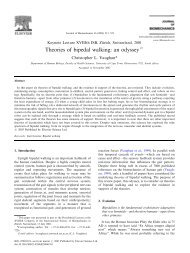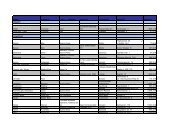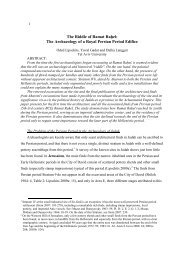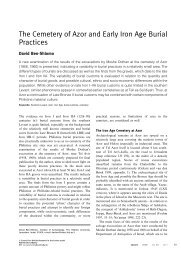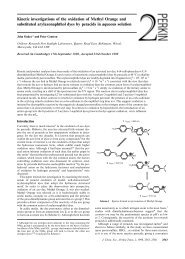Absorption and Transport of Cobalamin (Vitamin B12)
Absorption and Transport of Cobalamin (Vitamin B12)
Absorption and Transport of Cobalamin (Vitamin B12)
Create successful ePaper yourself
Turn your PDF publications into a flip-book with our unique Google optimized e-Paper software.
Annual Reviewswww.annualreviews.org/aronlineCOBALAMIN ABSORPTION & TRANSPORT 347Annu. Rev. Nutr. 1982.2:343-369. Downloaded from arjournals.annualreviews.orgby Hebrew University <strong>of</strong> Jerusalem on 11/18/08. For personal use only.is converted to tetrahydr<strong>of</strong>olate. In the absence <strong>of</strong> cobalamin the rate <strong>of</strong> thatreaction falls, accompanied by an accumulation <strong>of</strong> 5-methyltetrahydr<strong>of</strong>olate.This leads to the inability to form other folic acid vitamers, such as10-formyl- <strong>and</strong> 5,10-methylene-tetrahydr<strong>of</strong>olate, which are required forpurine <strong>and</strong> pyrimidine synthesis. Lack <strong>of</strong> these vitamers leads to megaloblasticanemia. This hypothesis, known as the methyl folate trap (118), hasbeen the subject <strong>of</strong> much debate <strong>and</strong> experimentation; <strong>and</strong> no clear-cutevidence is available to prove that trapping <strong>of</strong> 5-methyltetrahydr<strong>of</strong>olateactually occurs as a result <strong>of</strong> failure to convert homocysteine to methionineby the cobalamin-dependent methyl transferase.Indirect evidence has been <strong>of</strong>fered by Scott et al (141a) who have shownin monkeys exposed to nitrous oxide that subacute combinedegeneration<strong>of</strong> the spinal cord develops, <strong>and</strong> that this lesion can be minimized bymaintaining the methionine pool with supplemental dietary methionine.Scott & Weir (14 lb) have further discussed the hypothesis that kwashoirkoras wall as subacute combinedegeneration might be related to a deficiency<strong>of</strong> available methyl groups.D. Dietary Sources<strong>Cobalamin</strong> is made only by microorganisms in nature. Feces are a richsource since colonic microorganisms make large amounts <strong>of</strong> the vitamin.The usual dietary sources <strong>of</strong> cobalamin are meat <strong>and</strong> meat products <strong>and</strong> toa lesser extent milk <strong>and</strong> milk products. Fruits <strong>and</strong> vegetables have very littleor no cobalamins, <strong>and</strong> hence vegans <strong>and</strong> other strict vegetarians probablyderive their limited intake from foods or water contaminated with microorganismscontained in manure. <strong>Cobalamin</strong> biosynthesized in the colon is notabsorbed there. All strict vegetarians slowly develop cobalamin deficiency.<strong>Cobalamin</strong> present in foods is stable to high temperatures encounteredduring cooking but becomes labile if ascorbic acid is also present in theheated diet. The dominant forms present in foodstuffs are the enzymaticallyactive forms--i.e, adenosyl <strong>and</strong> methyl cobalamins, generally linked topolypeptides.E. Nutritional RequirementsThe recommended dietary allowance (RDA) for cobalamin for an adult3/zg (56). However, the requirements in patients may vary due to changesin the gastrointestinal tract, since damageither by a gastrectomy or ilealresection would eliminate normal absorption. Scott & Weir (141), Sullivan& Herbert (155), <strong>and</strong> others (13, 93) have confirmed the earlier studiesthe V<strong>and</strong>erbilt group (17a, 40a) that 0.5-1 #g <strong>of</strong> the vitamin given parenterallydaily provides maximum hematologic response. Using radioactivecobalamin, the daily turnover has been shown to be about 0.02% <strong>of</strong> the



